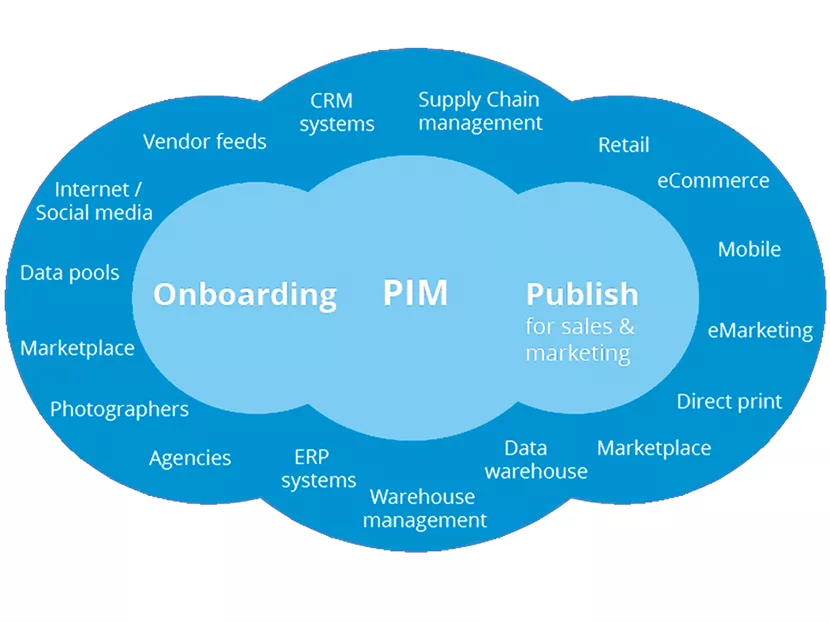E-commerce will continue to grow in PHCP distribution as a means to both transact business and as an enabling technology to disrupt full-service distribution with new models of business. Currently, the online participation rate of distributors, across the Durable Goods sector is approximately 15 percent of annual demand. Within this figure, however, is a Pareto Principle effect of performance where 20 percent of wholesalers transact 80 percent of the online volume. And, within the Pareto, are highly advanced firms that sell 25 percent of their volume online; almost all of these firms have Product Information Management software or PIM.
History and function
PIMs grew out the early days of e-commerce and specifically in retail in the EU. Early on, it was discovered that accurate and reliable product content was core to a competitive and satisfactory online experience. Customers that do not have accurate content quickly question the validity of their order and, often times, switch sites. Hence, we do not see penny pinching on accurate content to be prudent. Instead, we suggest wholesaler executives consider product content as the product knowledge component of their online sales effort.
Most B2B SKUs have 45 to 55 attribute fields with many requiring occasional updates and a few, such as cost, list, and quantity bracket(s), needing update often once per year (or more often). So, for every 1,000 SKUs, there are a potential of 45,000 to 55,000 attributes that need updating. And, if these attributes are in error, bad things can happen inclusive of over/underpayment; over/under billing to the customer; errant applications, which can lead to expensive rework or lost production time; and wrong ordering, which can impact returns and credit balances. Most wholesalers stock in the neighborhood of 5,000 to 15,000 SKUs, which means that there are, literally, millions of attribute fields that can be in error at any one time. The upshot is that we don’t see a PIM as an option for e-commerce and this is despite the current trend for wholesalers to rent content from an outside provider(s), develop their own using spreadsheets, or scrape it from a competitor’s site. The risk of error in operations, cost of rework, and loss of customer confidence in online offerings is simply too high to not invest in a PIM.
Leading PIMs have their roots in Western Europe, but there are new entrants that come from all parts of the globe. We refer to Forrester’s ranking of PIMs for B2B clients and the Q IV 2016 rankings have listed in the Strong Performers and Leaders categories. (Benfield Consulting, at the time of this installment, does not have existing endorsements or projects with PIM providers and refer clients to outside rankings.)
Again, there are other PIM solutions available, but we tend to stick with validated software done by outside parties with knowledge of PIM and e-commerce software and its uses.
The PIM process
The PIM is a default, software-based process for product content management and updates. Most PIMs have a common functionality including:
- A central repository for SKUs and their attribute fields. The repository is outside the ERP and content management system and is the main and, usually, the go-to source for all product information. The repository, in a sense, “pushes” data into the ERP and CMS and the central source eliminates error and creates efficiency by not having different product attributes in different places. The repository has data labeling options including common industry names or jargon, etc.
- Onboarding options to take incoming data from a variety of formats including XML, Flat Files, PDF, etc.
- Product/Application functionality, which groups different products, often from different vendors, to a common application for the customer.
- Data Curation and Content Enrichment or cross-pollination of attribute fields with similar data and matching of unstructured fields with structured data.
- Data and content gateways, which are tools for checking data for accuracy and quality.
- Digital asset management or portals linked to SKUs, applications etc., such as videos, breakdowns, and visual and descriptive supporting information.
- Controlled access features for users and maintenance of existing data and data downloads.
- Localization functionality for different languages, unique measurement systems, etc.
- Publishing functionality for different slices of data for specific marketing efforts within a variety of publications and formats — often called Data or Content Syndication.
Our research, depending on the wholesaler vertical market, finds that fewer than 20 percent of distributors have PIMs and choose to secure and manage content by other means. In recent years, content has been offered for co-op members or through industry data associations for a fee. Many of these efforts are commendable, especially for smaller firms with limited resources. However, there are limited means by which individual wholesalers can vet the quality, accuracy, and timeliness of the content they receive. There are also no timely means, that we know of, where these services can provide publishing functionality or content syndication. Since content syndication is a very important part of automated marketing, we almost always suggest clients invest in a PIM and get optimistic with the idea that, to lead in e-commerce, one must actively manage and control proprietary content.
The future of PIM
We are bullish on the future of established PIM software. It has been time-proven as a necessity for leading online distributors. In the early days of B2B e-commerce, where many of the leading firms got started, the PIM was often the first element of the software suite before the transaction platform. These companies, to us, knew the importance of content and the necessity of quality content for a competitive online offering.
For distributors who don’t have a PIM, our recommendation is to contact the sales arm of several software providers and go through an on-site demonstration. This is means by which we became interested in and stalwarts of the software many years ago. The meeting should be attended by materials managers, purchasers, IT, sales management, and appropriate executives. PIM is an expensive investment and having a group review of its functionality and benefits is recommended. PIM software vendors compete with each other. The software will grow in functionality as more SKUs go online and a broader array of market segments are reached.





